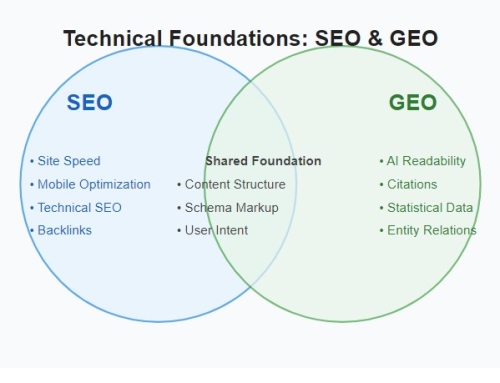“The art of life is a constant readjustment to our surroundings.” – Kakuzo Okakaura
The evolution of search has created a unique challenge: how do we write content that resonates with human readers while being optimally understood by AI systems? Let’s build a framework that serves both masters effectively.
Understanding Your Dual Audience
The Human Reader Seeks:
- Clear, engaging information
- Scannable content
- Practical solutions
- Emotional connection
- Visual appeal
The AI Engine Looks For:
- Structured information
- Clear relationships between concepts
- Authoritative citations
- Statistical validation
- Contextual relevance
The Architecture of Dual-Purpose Content
Foundation Layer: Core Structure
- Topic Clustering
- Main topic identification
- Subtopic organization
- Relationship mapping
- Semantic connections
- Content Hierarchy
- Clear H1-H6 structure
- Logical flow progression
- Information layering
- Strategic depth building
Human Layer: Engagement Elements
- Narrative Flow
- Compelling introductions
- Storytelling elements
- Personal connections
- Practical examples
- Visual Organization
- Strategic white space
- Bullet points and lists
- Infographics and images
- Highlighting key concepts
AI Layer: Machine-Readable Elements
- Entity Relationships
- Clear concept connections
- Defined relationships
- Contextual linking
- Topic association
- Data Integration
- Statistical validation
- Authoritative citations
- Structured data markup
- Fact verification
Writing Techniques for Both Audiences
Content Development Process
- Research Phase
- Topic research
- Keyword analysis
- Citation gathering
- Statistical data collection
- Structure Planning
- Content outline
- Information hierarchy
- Citation placement
- Data integration points
- Writing Phase
- Clear topic sentences
- Supporting evidence
- Narrative elements
- Engagement hooks
- Optimization Phase
- Human readability check
- AI readability enhancement
- Citation verification
- Structure validation
-
Citation Integration
- Use authoritative sources
- Include publication dates
- Link to primary sources
- Provide context for statistics
Visual Element Integration
- Relevant images
- Data visualizations
- Process diagrams
- Concept illustrations
Quality Assurance Checklist
Human Readability
- Clear narrative flow
- Engaging introduction
- Scannable structure
- Practical value
- Emotional connection
AI Readability
- Proper heading hierarchy
- Clear entity relationships
- Statistical validation
- Citation structure
- Semantic markup
Technical Elements
- Schema markup
- Meta descriptions
- Alt text
- Internal linking
- Citation formatting
Measuring Success
Human Metrics
- Time on page
- Scroll depth
- Social shares
- Comments
- Return visits
AI Metrics
- Featured snippet inclusion
- AI search appearances
- Citation pickups
- Knowledge panel inclusion
- Rich result generation
Next Steps for Implementation
- Audit existing content
- Create content templates
- Develop citation database
- Build statistical repository
- Implement measurement systems
Up Next: “Advanced Citation Strategies: Building Authority for Humans and AI”









